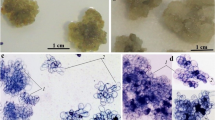Abstract
Calli and suspension cultures were obtained following inoculation of the explant from leaves ofGinkgo biloba L. on the supplemented MS basal medium. The obtained calli and suspension cultured cells were able to produce detectable amounts of ginkgolides which are known as natural specific PAF antagonists. The production of ginkgolides in the calli and suspension cultured cells were identified using GC/MS, GC and HPLC with authentic compounds. Since the production of ginkglides A and B in the calli and suspension cultured cells had been confirmed, effects of types and concentration of plant growth regulators, media and illumination on the induction and growth of the callus were studied. The concentrations of growth regulators for optimal callus induction were 1.0 to 2.0 mg/L for NAA and 0.1 mg/L for kinetin. The growth of the callus seemed to be more stimulated with the combination of NAA and kinetin than NAA and BA with illumination at all concentration ranges of 1.0 to 4.0 mg/L for NAA and 0.1 to 1.0 mg/L for kinetin or BA studied. Among 8 different media used, the induction rate of callus on Anderson, Eriksson, and Schenk and Hildebrant at 4 weeks after the innoculation was almost the same as that of MS. However, callus was rarely induced on Heller or White medium. Suspension cultures were easily initiated with 3 g of callus (fresh weight) derived from ginkgo leaves on supplemented MS medium. A typical growth curve of suspension cultured cells could be obtained by measuring the fresh weight of the suspension cultured cells at every 3 days. To improve the growth of suspension cultured cells of ginkgo, effects of concentrations of NAA, sucrose, phosphate ions and molar ratio of NH4 + to NO3 − ions in the culture medium were studied. The maximum growth of the cells was achieved when the culture medium contained 1.0 mg/L of NAA, 30 g/L sucrose, 1.75 mM phosphate ions and 1∶5 molar ratio of NH4 + to NO3 − ions.
Similar content being viewed by others
References Cited
Braquet, P., The ginkgolides: Potent platelet-activating factor antagonists isolated fromGinkgo biloba L.: Chemistry, Pharmacology and Clinical Applications.Drugs of the Future, 12, 643–699 (1987).
Braquet, P., Treatment of prevention of PAF-acether disorders provoked by a new series of highly specific inhibitors BE 90,915: GB Patent Appl. 84/18, 424 (July 19, 1984) Belg, BE 90,915 (see CA 103:189808 d), (1984).
Carrier, D. J., Cosentino, G., Neufeld, R., Rho, D., Weber, M. and Archambault, J., Nutritional and hormonal requirements of Ginkgo biloba embryo-derived callus and suspension cell culture.Plant Cell Reports, 8, 635–638 (1990).
Dive, G., Godfroid, J. J., Lamotte-Brasseur, J., Batt, J. P., Heymans, F., Dupont, L. and Braquet, P., PAF-receptor 1, “Cache-Oreilles”, Effect of selected high potency platelet-activating factor (PAF) antagonists.J. Lipid Mediator, 1, 201–215 (1989).
Huh, H. and Staba, E. J., The botany and chemistry ofGinkgo biloba L..J. of Herbs, Spices, and Medicinal Plants, 1, 91–124 (1992).
Huh, H. and Staba, E. J., Ontogenic aspect of ginkgolide production inGinkgo biloba.Planta Med., 59, 232–239 (1993).
Hosford, D., Jean-Michel Mencia-Huerta, Page, C. and Braquet, P., Natural antagonists of platelet activating factor.Phytotherapy Research, 2, 1–24 (1988).
Kuster, L. J., Filep, J. and Frolich, J. C., Mechanism of PAF-acether-induced platelet aggregation in Man.Thromb. Res., 43, 425–433 (1986).
Lobstein-Guth, A., Briancon-Scheid, F. and Anton, R., Analysis of terpenes fromGinkgo biloba L. by high performance liquid chromatography.J. Chromatogr., 267, 431–438 (1983).
Nakanishi, K., The ginkgolides.Pure Appl. Chem., 14, 89–113 (1967).
Nakanishi, K. and Habaguchi, K., Biosynthesis of ginkgolide B, its diterpenoid nature, and origin of the tert-butyl group.J. Am. Chem. Soc., 93, 3546–3547 (1971).
Nunez, D., Chignard, M., Korth, R., Le Couedic, J. P., Norel, X., Spinnewyn, B., Braquet, P. and Benveniste, J., Specific inhibition of PAF-acether-induced platelet activation by BN52021 and comparison with the PAF-acether inhibitors, kadsurenone and CV-3988.Eur. J. Pharmacol., 123, 197–207 (1986).
Schwabe, W. and Kloss, P., Recovery of vasoactive drugs from leaves ofGinkgo biloba, German Patent, 1,767,098, May 31 (from C.A. 78: 133641) (1972).
Schwabe, W., In: Tebonin, Tebonin forte., Schwabe Co. (ed), Karlsruhe, pp. 7–9; pp. 23–24; pp. 48–49 (1986).
Tallevi, S. G. and Kurz, W. G. W., Detection of ginkgolides by thin layer chromatograpy.J. Nat. prod., 52, 624–625 (1991).
Teng, B. P., Chemistry of ginkgolide, In Braquet, P. (Ed),Ginkgolides Chemistry, Biology, Pharmacology and Chemical Perspectives. Vol. 1, J. R. Prous Science Pub., Barcelona, 1988, pp. 37–42.
van Beek, T. A., Scheeren, H. A., Rantio, T., Melger, W. C. and Lelyveld, G. P., Determination of ginkgolides and bilobalide in Ginkgo biloba leaves, extracts and phytopharmaceuticals.J. Chromatogr., 543, 375–387 (1991).
Wenche, N. A. and Rolfsen, K., PAF antagonist from natural products.Drugs of the Future, 15, 597–603 (1990).
Author information
Authors and Affiliations
Rights and permissions
About this article
Cite this article
Jeon, M.H., Sung, S.H., Jeon, S. et al. Cultures ofGinkgo biloba, effect of nutritional and hormonal factors on the growth of cultured cells derived fromGinkgo biloba . Arch. Pharm. Res. 16, 244–250 (1993). https://doi.org/10.1007/BF02974490
Received:
Issue Date:
DOI: https://doi.org/10.1007/BF02974490




